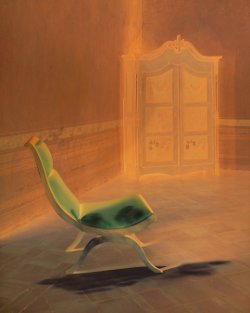
Véronique Ellena, Balthus's armchair, Villa Medici, Rome, 2008 (shooting) 2017-2018 (print), ex. 2/5, lambda print from negative 4x5, 150 x 120 cm © Véronique Ellena. Purchase with the help of FRAM
The Musée Réattu owes its first encounter with Véronique Ellena to Christian Lacroix. When he was awarded carte blanche in 2008 to take over the museum, the designer chose to invite a completely unprecedented cohort of artists to the institution like Guillaume Janot, Bernard Quesniaux and Véronique Ellena. The latter’s photographs, scattered at various points, turned out to be the most suitable to initiate a fruitful dialogue with the museum collections: her Cyclistes rubbed shoulders with Jacques Réattu’s La vision de Jacob and medieval Christ from Mas-Thibert Church, her Natures mortes from the Villa Médicis with those by the Provençal painter Meiffren Conte. Through the direct comparison of these works in different periods and media, Christian Lacroix thereby brought something to light: Véronique Ellena’s photographs would find in the Musée Réattu an environment within which a work could flourish convening with so much skill the realm of painting. That is why ten years later, the Musée Réattu decided to hold the artist’s first retrospective. This exhibition reflects thirty years of creation and proposed an original interpretation of her emblematic series (Les Grands moments de la vie, Les Classiques cyclistes, Natures mortes, Les Invisibles etc.), as well as delving into completely new and experimental work: Les Clairs-Obscurs. Les Clairs-Obscurs emerged from an aesthetic revelation. The artist, who in 2016 set about digitalising an analogue shot/film– that of a photograph taken in 2008 in the former apartments of Balthus at the Villa Médicis –, decided to develop it and enlarge it as is. Simple yet tremendous, this process revolutionised Véronique Ellena’s photographic world. Thereby drawing upon the origins of photography – a mechanical tool to reproduce reality– and at the source of ‘inhabited’ places, Les Clairs-Obscurs end up forming a suite of visual tales with an almost metaphysical dimension, multiplying bridges between reality and fiction, past and present, while retaining the slight spirituality that has run through the artist’s work since the outset. The Musée Réattu was interested in this body of works in the context of an acquisition sustaining Véronique Ellena’s presence in its collections. Five photographs, two of which were specifically conceived for the occasion, were chosen with the artist to link up as closely as possible with the permanent collections, fine arts and photography alike. All support the principle of the poetical reinterpretation of the history of art that the museum implements through its hangings and exhibitions. Ultimately Véronique Ellena finds her place within the museum’s photography collections through the conceptual approach of this collection. By exploring the plastic abilities of analogue shot/film – transparency, colours, ability to enlarge – she extends her own reflection on the medium of which the museum has kept several examples since the seventies: Pierre Cordier’s Autochimigrammes; Formol’s Band, Les Astéroïdes and Les gémelles by Patrick Bailly-Maître-Grand (periphotography and monotypes); Yves Trémorin’s Electronogrammes (images obtained without light using an electronic microscope); Nancy Wilson-Pajic’s Déesses (cyanotype photograms); and Katerina Jebb’s Icônes sans titre (scans of haute couture dresses).